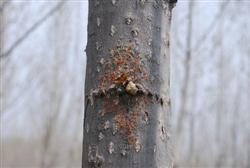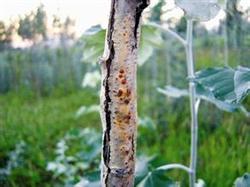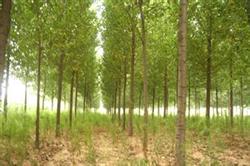The rot disease of poplar and its control

Poplar is a general name for deciduous trees of the genus Populus in the family Populus. There are more than 100 species in all genera, mainly distributed in temperate zone, cold zone, Mediterranean coastal countries and Middle East in Europe, Asia and North America. There are more than 50 species in China. Wood is used as civil building materials for the production of furniture, matchsticks, sawn timber, papermaking, etc., as well as wood-based panels and fiber materials. Leaves are good fodder. Poplar is also the main tree species for timber forest, shelterbelt and side greening. Over the years, China has made a lot of achievements in poplar scientific research, and successfully introduced and selected a number of excellent poplar clones. After large-scale popularization, it has formed huge productivity and remarkable economic benefits. The high-yield cultivation techniques were combined into high-yield cultivation models and supporting techniques, which shortened the rotation period and improved the yield and wood quality. Some effective methods and integrated control techniques were put forward in the prevention and control of poplar diseases and insect pests. Due to the adoption of excellent poplar varieties and middle-yield cultivation measures, the yield per unit area of newly built poplar plantation in China has been increased and the rotation period has been shortened in the past ten years. In recent years, due to the implementation of the national afforestation project of returning farmland to forests and the fourth phase of the "three North" shelterbelt, many provinces and cities have created a large number of high-yield poplar forests in the project construction. at present, the area of poplar plantation in the country is about 6 million hectares, accounting for 19% of the total area of the country and four times the area of poplar plantation in the world. Because poplar is easy to be infected with diseases and insect pests, it is difficult to consolidate or even fail in the project. In recent years, rot (also known as skin rot) is the main cause of death of poplar. Most poplars, especially fast-growing varieties, may be infected. First, symptoms of poplar rot. Poplar cadres and branches are the sites of skin rot. It can be divided into two types: dry rot and withered branches. 1. Dry rot: it mainly occurs at the main pole, big branches and bifurcations. The initial stage of the disease is dark brown, watery spots, slight swelling, cortical tissue decay and softening, subcutaneous wine lees smell, water exudation by hand pressure, and then water loss and subsidence, sometimes the bark of the diseased part collapses, and even becomes filamentous, and the disease spot sometimes has obvious dark brown edges. Under suitable conditions, the vertical expansion is faster than the horizontal expansion. When the diseased part surrounds the trunk for a week, the above part will die, the cortex will rot, the fiber will separate like hemp, and the sapwood will change color easily from the xylem. In the later stage, there are many needle-like protuberances on the disease spot, that is, the conidium of bacteria. In wet weather, yellow, orange or red filamentous conidia horns are extruded from the orifice of conidia. 2. Tip blight: it mainly occurs on seedlings, young trees and branches of big trees. The disease was dark gray at the beginning of the disease, and the disease expanded rapidly. After a week, the upper branches withered and died. 2. The cause and regularity of poplar rot disease the disease is mainly fouling black crustacean of ascomycetes, and its anamorph is Cystis aureus. The mycelium and immature fruiting body overwintered in the diseased tissue. Conidia and mature conidia were produced in the overwintering spot, which became the main source of infection in the same year. The disease began in April of the following year, and the first peak was formed from late May to June. The disease slowed down when the temperature increased from July to August, and the second peak appeared in September, when the pathogen originated from the conidia formed by disease spots in spring of that year and stopped after October. The disease begins to occur when the temperature is more than 10 ℃ and the relative humidity is more than 60% in spring, and it is the most suitable for disease when the temperature is 24-28 ℃. The bacteria enter from the wound or lenticels and the incubation period is about 1 month. It takes 2-3 months from the onset to the formation of conidia, and the cyst cavity and ascospores are formed on the lesion in autumn. Latent infection is an important feature of poplar canker. Ascomycetes spread to the host cortex by the wind, invade by the wound, and show the disease again after winter. When the tree is weak, it is conducive to the occurrence of diseases. Some of the disease spots on the sturdy trees at that time can heal naturally the following year. In the same diseased tree, the disease spot on the sunny side is more than that on the shady side. Untransplanted seedlings are generally free from disease or mild disease. Once transplanted, the water is out of balance, the tree is weak, and the disease is easy to occur. The peak of incidence in spring was the result of infection in the autumn of the year before last, not in the spring of that year. When afforestation in spring, the new disease spot on the first planted young forest is also caused by infection in the nursery in the first year. Therefore, the number of bacteria carried by seedlings is closely related to the disease degree of young trees in new woodland. The arid and barren site condition is an important inducement of the disease, and it is also the main reason why canker is particularly common and serious in the arid and semi-arid "three north" areas of China. A large number of root damage during seedling initiation and a large amount of water loss of seedlings during afforestation are the internal reasons for the disease of newly planted young trees. There were significant differences in resistance to canker among different species and strains of poplar. White poplar species are resistant to disease, black poplar species are moderately resistant, while poplar species are more susceptible to disease. Most of the hybrid lines of poplar and black poplar are also susceptible to disease. Green poplar, small green poplar, mass poplar and Beijing poplar are all highly susceptible poplars. Among the resistant factions, some strains are susceptible, such as Populus tomentosa is a more resistant tree species, some of them (triploid Populus tomentosa) are very susceptible. There are also resistant strains among the susceptible types. At the same time, the susceptibility of tree species is also closely related to their environmental conditions. Third, prevention and control measures of poplar rot. To improve the growth potential of trees and increase their resistance is the fundamental way to prevent and cure this disease. When planting ⑴, select suitable soil and varieties to achieve suitable land and trees. Strict technical regulations to improve disease resistance. Strong seedlings were cultivated by ⑵. Cuttings should be stored in a cool place below 2.7℃, so as not to reduce cuttings vitality, avoid long-distance transportation of seedlings, carefully fake planting, soak roots for more than 24 hours or dip in mud before afforestation. ⑶ planting after tending and management, control stem borer, reasonable pruning without leaving stumps. Pruning should be carried out in winter and try to avoid pruning in the rainy season. To avoid intensity pruning, the cutting edge should be disinfected with stone-sulfur mixture, or smeared with wuningmycin or sprayed with high concentration. ⑷ should remove and burn seriously infected poplars in time to avoid the spread of pathogens. The seriously infected stand was thoroughly removed so as not to form a new source of infection and infect a larger area of the stand. ⑸ strengthens the management of woodland tending to promote the vigorous growth of trees. Before entering winter or before the germs propagate and spread in early spring, high concentration fungicides should be sprayed on the trunk of young trees, and the middle-aged forest should be coated with fungicides, stone-sulfur mixture, or Bordeaux liquid to prevent the disease. it is better to treat diseased trees by scraping off the disease spots and then brushing them. Practice has proved that obvious new myogenic wounds healed after 15 days of application of fungicides at the site of the disease. The less susceptible plants or stands of ⑹ should scrape off the disease spots with a knife while strengthening the management and improving the growth potential of the forest, which should be scraped to the healthy part, and then sprayed or smeared dry. The optional chemicals are 10 times edible alkali water, or 20% agricultural anti-120 water agent 10 times, 50 times 40% Fumei arsenic, 50% carbendazim 100 times, 5% topiramate, carbendazim, etc., apply 2-3 times continuously.
- Prev

Skin rot of poplar and its control methods
Skin rot, also known as rot, is mainly distributed in Northeast, Northwest and North China. It mainly harms the branches of trees and is highly contagious. once the disease is prevalent, it often causes a large area of forest death and great losses. In recent years, due to large-scale planting of poplar, the disease often occurs everywhere, a single poplar variety is planted.
- Next

Poplar pest control
Poplar pests can be divided into the following categories in terms of damage methods and control measures: first, leaf-eating pests: mainly poplar fan boat moth, poplar small boat moth, poplar two-tail boat moth, poplar leaf borer, diamondback moth, beetle and so on. Poplar is damaged by the above pests from seedling stage to mature stage, causing leaf defect or eating up.
Related
- Fuxing push coffee new agricultural production and marketing class: lack of small-scale processing plants
- Jujube rice field leisure farm deep ploughing Yilan for five years to create a space for organic food and play
- Nongyu Farm-A trial of organic papaya for brave women with advanced technology
- Four points for attention in the prevention and control of diseases and insect pests of edible fungi
- How to add nutrient solution to Edible Fungi
- Is there any good way to control edible fungus mites?
- Open Inoculation Technology of Edible Fungi
- Is there any clever way to use fertilizer for edible fungus in winter?
- What agents are used to kill the pathogens of edible fungi in the mushroom shed?
- Rapid drying of Edible Fungi

